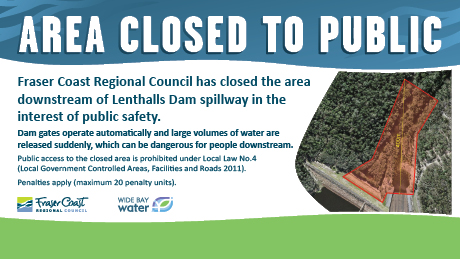Water Quality and Dam Safety
Fraser Coast Regional Council conduct routine water quality testing and catchment health monitoring of Lake Lenthall and the catchment area. There are three main purposes for this:
- This water is used for the town’s drinking supply
- The lake and river is used for recreation by the community
- Compliance with legislation for monitoring water quality.
Blue-green Algae (BGA)
Blue-green algae (BGA) or cyanobacteria occur naturally in marine and freshwater environments such as rivers and lakes. Some species of blue-green algae are known to produce toxins that can be harmful to both humans and animals.
The effects of blue-green algae on humans can include rash, nausea, eye and ear irritation, headache, vomiting, abdominal pain, diarrhoea, gastroenteritis, muscle weakness, pneumonia and paralysis. These symptoms can occur by coming in contact with the water through recreational activities such as swimming, canoeing, boating, eating fish or other aquatic life or ingesting untreated water.
The population of blue-green algae in Lake Lenthall and the Burrum Weirs varies throughout the year and is monitored through routine water testing. Populations are known to increase under high nutrient conditions, still water with low turbulence, warm sunny weather and weather patterns that are stable for a long time.
The recreational hazard varies depending on the number and type of blue-green algae present in the water body. As the hazard status increases so does the likelihood of irritation or adverse health outcomes if you come in contact with the water.
- High level - indicates there is a high possibility of some form of irritation.
- Moderate level - indicates that there is a possibility of irritation.
- Low level - indicates there is unlikely to be health problems to the average person.
It is important to remember that some people are more sensitive than others and this should be considered before coming in contact with the water.
Certain activities may be restricted when the hazard status reaches Moderate or High. Check with the Ranger before using the waterway as to the status of BGA levels.
Visitors are advised not to drink water directly from Lake Lenthall or the Burrum River. Boiling water will not reduce the risk from blue-green algae.
Fraser Coast Regional Council advises to only drink treated water and that visitors must bring their own treated drinking water to the Lake.
Blue-green algae and other pollutants found in raw water are removed from water through treatment at a water treatment plan, making it safe to drink.
Dam Safety Exclusion Zone
A well signed exclusion zone exists above and below the dam wall for visitor safety. The crest gates on the dam wall can operate automatically and pose a serious safety risk to anyone within this vicinity.
There is no access to this exclusion at any time. Anyone found within this exclusion zone may receive on-the-spot fines.
Emergency action plan
As the owner and operator of Lenthalls Dam, Council ensures that the necessary inspections, monitoring and maintenance is undertaken to ensure all aspects of the dam remain in good working order.
Council is responsible for managing emergency events which may arise in relation to the dam. The Emergency Action Plan outlines these emergency events and the necessary actions to be taken. Importantly the Emergency Action Plan identifies the relevant authorities and potentially impacted persons to notify in the event of an emergency. The emergency events covered are:
- Flooding
- Chemical spills
- Piping (localised failure of the dam wall)
- Earthquake
- Terrorist/high energy impacts
To view all QLD Dam Emergency Actions plans, or print the Lake Lenthall Emergency Action plan, click the buttons below.

